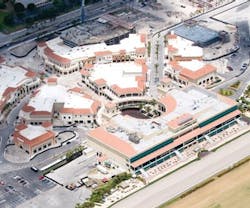If your roof, deck, or insulation is developing water droplets, chances are your forehead is too. But with proper design and maintenance principles, you don't have to sweat roof condensation issues.
Although moisture problems in the roof assembly can be due to waterproofing deficiencies, don't neglect the effect of condensation. Depending on a building's use and location, some scenarios can present condensation problems.
Air leakage from within a building carries moisture that can result in condensation in the roof assembly, notes Richard L. Fricklas, former technical director emeritus of the Roofing Industry Educational Institute. Familiarize yourself with the following conditions so you can keep condensation failures out of your facility.
THINGS TO KNOW ABOUT THE Stack Effect
Roofs are vulnerable to condensation anytime warm, moist interior air rising up through a building comes into contact with a cold roof assembly.
"In areas with more heating days per year, generally in the north, wintertime becomes problematic. When humid air from the interior makes contact with the underside of the roof surface, the water vapor it's carrying turns into liquid water," explains Jose F. Ponce, technical specialist with Professional Roof Consultants. "Think of a cold drink sitting out on a summer day. The same phenomenon happens with roof systems."
Now is a good time to look for warning signs. Keep an eye out for drips, usually observed at midday when the sun is shining and the membrane's temperature is on the rise, recommends Craig Tyler, architect and specification developer for Carlisle Construction Materials. Don't assume dripping is from leakage.
Roof cuts and thermographic imaging can also detect moisture, in addition to other strategies.
"Cracking noises can sometimes be heard when walking on the roof during wintertime, as a thin layer of ice breaks," he adds. "On structural concrete and possibly wood planks, or plywood, moisture drips may not be observed. But frozen moisture can be detected in the form of spongy, buckled, or warped insulation beneath the membrane."
Pay attention to reflective roofs that are designed to reduce heat gain by using both solar reflectivity and thermal emissivity to remain cool. Cool roof temperatures may increase the possibility of condensation if warm, moist air from the interior comes into contact with the assembly.
"Cool roofs can include asphalt built-up membranes like fiberglass, modified bitumen, and torchdown; single-ply membranes like TPO, PVC, and EPDM; metal panels; coatings; and even shingles," explains Dale W. Apple, technical specialist with Professional Roof Consultants. "A very common misconception is that all cool roofs are white and single-ply membranes."
Any material that redirects the sun's rays and reroutes heat to its surroundings can be classified as a cool roof by the Cool Roof Rating Council, as long as its solar reflectivity and thermal emissivity values correspond to the climate.
Remedial action depends on the intensity of condensation, but it can be as severe as system replacement, Tyler says.
"In less costly options, wet insulation can be replaced in affected areas and a darker colored membrane can be installed, possibly with a fleece backing, allowing the system to warm a little," he adds. "If the structure can sustain added weight, you can convert the roof into an inverted membrane assembly by simply adding polystyrene insulation, protection fabric, and stone ballast." PageBreak
WHERE THE WORST CONDENSATION HAPPENS
Although metal roofs may present the same issues as above, there are different condensation concerns with metal construction.
RELATED ARTICLES
"Problems are usually related to high relative humidity inside the building and the lack of proper ventilation, insulation, or vapor retarder," says Rodger Russ, North American sales manager of roofing at Butler Manufacturing. "Metal roofs on pre-engineered buildings don't have a solid deck, so their problems are more envelope related. Any time humidity creeps upward of 50%, should moisture-laden air permeate the vapor retarder and insulation and come into contact with the metal roof, there is the propensity for condensation to form."
Manufacturing facilities and large structures like gymnasiums are particularly vulnerable to this kind of problem.
"Buildings that house machines or an excessive amount of people can have trouble," Russ says. "Anything that dumps a lot of moisture into the air is a red flag."
Also keep an eye out for mold and droplets developing on the surfaces of the roof assembly.
One of the easiest ways to mitigate humidity is with basic ventilation, explains Russ.
"For many cases, adding fans can take care of this issue," he adds. "Other solutions include adding more insulation or a more substantial vapor retarder, which is often difficult to do after the fact."
RECORD KEEPING WITHOUT A HEADACHE
If condensation problems conflate, then water leads to mold, wet insulation, and roof failure. Keep a roof system historical file to stay on top of the situation.
Your file should contain a detailed history of the roof installation, repairs and changes, and a maintenance plan, notes James R. Kirby, vice president of sustainability at the Center for Environmental Innovation in Roofing.
RELATED: Diagnosing envelope leaks
It should also contain original plans and specifications, warranties, thorough documentation of maintenance and repairs, and even samples of roof system materials, he adds. The historical file should be kept with the building when sold and purchased, which can be especially useful when tracking the building's use.
In the specific case of a large metal building with minimal insulation and no vapor retarder, the end use of the building was never made known to the manufacturer and engineer, says Russ. It housed a kiln to dry wood, and the excess moisture from the drying process caused insidious problems that necessitated a severe solution.
"No one knew there was a problem until a maintenance worker put his foot through the roof," he explains. "That situation required full-scale replacement."
